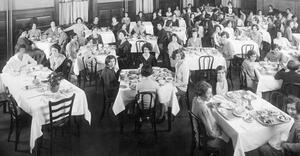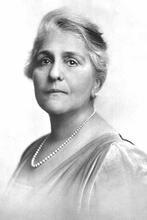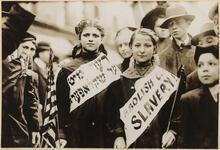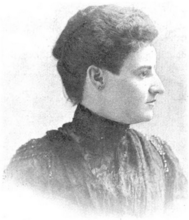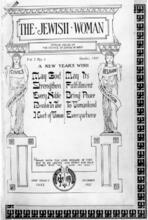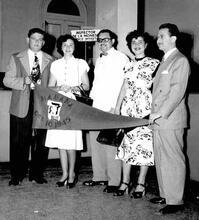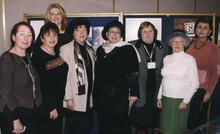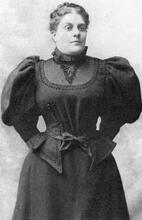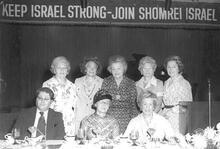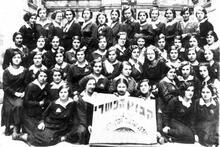Clara De Hirsch Home for Working Girls
The Clara de Hirsch Home for Working Girls was one of several charitable organizations established by "uptown", primarily German, Jews, on behalf of their "downtown" Eastern European immigrant co-religionists. It was founded in 1897 with the mandate to "improve [young immigrant women's] mental, moral and physical condition, and train them for self-support."
Institution: 92nd Street Y, New York City.
The mission of the Clara de Hirsch Home for Working Girls, in the eyes of its leaders, was to “improve [the girls’] mental, moral and physical condition, and train them for self-support.” Named for philanthropist Baroness de Hirsch and founded by middle-class German Jewish women, the Home pursued this mission by providing lodging, job training, religious instruction, and cultural and social activities, in the hopes that the women it served—mostly poor or recent immigrants between the ages of sixteen and 30—would be uplifted mentally, socially, and morally. This mission, perhaps patronizing but typical among charitable organizations of the early twentieth century, did in fact provide the women with marketable skills and, for some, “a home in the truest sense of the word.”
Overview
Concerned about the welfare of young working girls in New York City at the turn of the twentieth century, a group of Jewish leaders, mostly women, founded the Clara de Hirsch Home for Working Girls in May 1897. The original board of directors consisted of eleven women and two men. Funds were supplied by the Baroness de Hirsch, who had written to her friend Oscar Straus, the German Jewish political activist and philanthropist, a year earlier expressing her interest in such a project. The baroness donated $200,000 for the construction of the home and pledged additional funds to maintain it once completed. After a few years in temporary quarters, the home was permanently established on East 63rd Street in Manhattan.
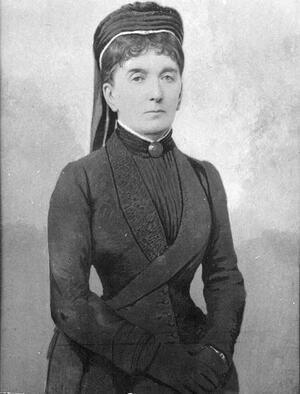
As a young woman, Baroness Clara de Hirsch (née Bischoffsheim, born Antwerp, June 13, 1833; died in Paris, April 1, 1899) assisted her father in his work, becoming knowledgeable in business, legislative and philanthropic affairs. After her marriage to Baron Maurice de Hirsch in 1855, she guided his interests towards philanthropy, and specifically, towards aiding the poor, persecuted, and oppressed of his co-religionists. Designated his sole administrator, she dispensed fifteen million dollars in charity to organizations around the world after his death. Among the beneficiaries of her largesse was the Clara de Hirsch Home for Working Girls, to which the Baroness gave a total endowment of $800,000.
Institution: 92nd Street Y, New York City.
Directors of the Clara de Hirsch Home provided their young, largely immigrant charges with comfortable lodging, vocational training, and social activities. Their mission, as they saw it, was to “improve [the girls’] mental, moral and physical condition, and train them for self-support.”
The Clara de Hirsch Home became a model for similar trade schools throughout the country and was one of many charitable organizations established by “uptown” Jews, primarily of German origin, who had established themselves in the United States by the mid-nineteenth century, on behalf of their Eastern European immigrant co-religionists. Most of the home’s directors were drawn from New York’s German Jewish community. Rose Sommerfeld, who was the home’s resident director from 1899 through 1926 and who had a profound impact upon its development, was a German Jewish woman from Baltimore. Sommerfeld’s background and experience were similar to those of many female settlement workers of her day. She was middle-class, unmarried, and dedicated to her work with the underprivileged. Before coming to the home, she had been associated with the National Council of Jewish Women, the Frank Free School (for Russian Jewish children), and the Daughters of Israel Working Girls Home in her native city.
Sommerfeld was involved in every aspect of the home’s program, and took a personal interest in its residents and staff members. As Sarah Straus, another of the home’s founders, wrote of Sommerfeld in the home’s annual report of 1901, she took responsibility for “the moral and material welfare of the girls under her charge [and] by her rare judgment and tact she wins their respect, love and confidence.” And, as Straus added in 1905, Sommerfeld “is wont to be considered a personal friend of each girl who has lived in the home.”
Accommodations and Activities
Girls were referred to the home by various individuals and groups, both Jewish and non-Jewish. Among these were the National Conference of Jewish Charities, synagogue sisterhoods, the Hebrew Orphan Asylum, the Hebrew Sheltering Guardian Society, the National Council of Jewish Women, Educational Alliance, Charity Organization Society, the New York City Department of Charities and Board of Education, and the settlement houses. In many cases, the referring organization, or the home itself, provided scholarships to cover the girls’ tuition and living expenses (amounting to $3 per week for each). The home opened with accommodations for thirteen girls; by 1912–1913, over 140 girls lived at the home, more than 70 of whom were trainees.
The home offered boarding facilities for working women, age sixteen to 30, who were either orphans or had no relatives in the city. Its training department instructed girls over age fourteen, most of whom were also residents of the home, in either “domestic science” (housework, cooking, laundry, mending, etc.) or “industrial skills,” such as hand sewing, machine sewing, dressmaking, and millinery. Students enrolled in one of these departments for a twelve-month course of study, which also included elementary education (especially English-language instruction) and physical exercise. Many girls also supplemented this curriculum with board of education lecture courses or typing and stenography classes outside the home. In addition, the girls were responsible for daily cleaning of their own rooms, as well as basic upkeep of the home.
Jewish religious instruction was also incorporated into the home’s program. While the home was open to non-Jews, these were to constitute no more than ten percent of the total number of residents. Jewish boarders and trainees celebrated Jewish holidays, such as Lit. "dedication." The 8-day "Festival of Lights" celebrated beginning on the 25th day of the Hebrew month of Kislev to commemorate the victory of the Jews over the Seleucid army in 164 B.C.E., the re-purification of the Temple and the miraculous eight days the Temple candelabrum remained lit from one cruse of undefiled oil which would have been enough to keep it burning for only one day.Hanukkah, Holiday held on the 14th day of the Hebrew month of Adar (on the 15th day in Jerusalem) to commemorate the deliverance of the Jewish people in the Persian empire from a plot to eradicate them.Purim, and A seven-day festival to commemorate the Exodus from Egypt (eight days outside Israel) beginning on the 15th day of the Hebrew month of Nissan. Also called the "Festival of Mazzot"; the "Festival of Spring"; Pesah.Passover. They attended Sabbath services on Friday evenings (using the Reform Hebrew Union Prayerbook), and were encouraged to attend nearby “uptown” synagogues, using seats provided for them by the trustees. However, the home, while Term used for ritually untainted food according to the laws of Kashrut (Jewish dietary laws).kosher, was not strictly observant and provided only minimal religious education, consisting of one hour of Biblical history a week.
In addition to formal education and vocational training, young residents participated in a variety of social and cultural activities. They could choose from several literary and social clubs (including cooking, millinery, “physical culture,” English, and German) and enjoyed musical and dramatic performances (particularly an annual minstrel show performed by the girls themselves). The young women had access to a library, evening lectures on a wide array of topics, and weekly teas, when the superintendent read aloud to the boarders while they sewed. The girls especially looked forward to frequent outings to museums, concerts, the theater, and parks. During the summer months, they were treated to boat trips, campfires, and picnics, and were sent to various camps, including the home’s own Welcome House Vacation Home in Long Branch, New Jersey, which provided rest and recreation to girls in need of gaining weight and restoring their health. On Sunday evenings, residents were encouraged to invite male visitors to join them in social dancing; as a result, according to the home’s 1909–1910 annual report, “the ‘dance hall,’ with its attendant evils, has no attraction for them.”
Home for Immigrant Girls
This reference to the “dance hall” reflects the concern of the home’s directors with the safety and sexual morality of young working women. Like their colleagues in the settlement house and working girls’ club movements, these women of the German Jewish elite sought to provide their charges with the means to earn a decent livelihood. They would then be able to help support their families and cultivate their self-respect. Most importantly, the women reformers hoped to protect their charges from the evils of city life, especially growing numbers of white slave traffickers who were known to lure innocent and desperate immigrant girls into prostitution.
This was the motivation behind the establishment, in May 1904, of a Home for Immigrant Girls by a group of women connected with the Clara de Hirsch Home. The new home provided temporary shelter for girls who had no one to meet them upon their arrival in the country, were unable to locate their relatives or lacked sufficient funds to reach their destinations. An agent representing the National Council of Jewish Women met the girls at Ellis Island and brought them directly to the home, where they received information and guidance.
In their efforts to guide and protect immigrant Jewish girls, the home’s directors seem to have been motivated by genuine sisterly concern, as well as by their class and ethnic interests. As members of the German Jewish community, they were anxious to Americanize their charges, and to “lift” them out of poverty into middle-class respectability. In the context of the home’s program, this meant training girls in domestic skills in the hope that they would internalize American middle-class ideals regarding a “woman’s place.” Despite the attention given to “industrial training,” girls at the home were prepared to be self-supporting before marriage, but ultimately to be good wives and mothers. Many, the benefactresses noted proudly, returned to the home to celebrate their weddings.
Successes in Social and Moral Uplift
It was this value system that prompted the home’s directors to steer their young charges into domestic service. In the nineteenth century, such positions were widely regarded as safe and appropriate for lower-class women. They would also provide graduates with the skills needed to eventually establish their own homes. Some historians such as Nancy Sinkoff have suggested that the home’s directors were also interested in training domestics to staff their own households. Whatever the motivations of the directresses, the home’s residents tended to reject domestic service for various reasons, generally preferring work in the garment trades.
Upon “graduation” from the home, girls found work as domestics, cooks, chambermaids, waitresses, infant nurses, seamstresses (in the garment shops), singers, actors, bookkeepers, or sewing teachers (especially in orphan asylums). Some qualified for positions as teachers, factory forewomen, or supervisors at other institutions, such as the Temple Emanuel Sisterhood Day Nursery and the Jewish Industrial Home for Girls in Philadelphia.
Despite their class biases and sometimes patronizing attitudes, the home’s directors provided their charges with marketable skills. Beyond that, they succeeded in creating an appealing home life for young women who had largely been deprived of this experience. As a reporter for the Hebrew Standard wrote in 1907, “The girl … enjoys many home-like privileges, for it is a home in the truest sense of the word. The rooms are well-lighted and well heated and the young woman, after many hours of work, comes home and finds much good cheer awaiting her. … In all [the girls] are a happy crowd.”
Over time, the home’s program was gradually modified in response to changing conditions. As immigration declined, and greater educational opportunities became available to the city’s young women, the directors decided, in 1926, to close their trade school. Beginning in the 1930s, the home sheltered growing numbers of young European Jewish refugees, as well as self-supporting students of various New York educational institutions.
In July 1960, the home’s board of directors sold its building on East 63rd Street and, a year later, concluded a merger agreement with the 92nd Street YMHA. The home contributed its assets toward the construction and maintenance of a new residential building that would accommodate two hundred women. It was completed in 1967.
Baum, Charlotte, et al. The Jewish Woman in America (1976).
Clara de Hirsch Home for Working Girls. Annual Reports: 1901, 1905, and 1909–1919.
Archival Collections. Jewish Division, New York Public Library, and 92nd Street YM-YWHA, NYC.
Glanz, Rudolf. The Jewish Woman in America: Two Female Immigrant Generations, 1820–1929. Vol. 2 (1977).
Rischin, Moses. The Promised City: New York’s Jews, 1870–1914 (1962).
Rothman, Sheila. Woman’s Proper Place: A History of Changing Ideals and Practices, 1870’s to the Present (1978).
Sinkoff, Nancy B. “Educating for ‘Proper’ Jewish Womanhood: A Case Study in Domesticity and Vocational Training, 1897–1926.” American Jewish History 77, no. 4 (June 1988): 572–599.
Welter, Barbara. “The Cult of True Womanhood, 1820–1860.” In The American Family in Social-Historical Perspective, edited by Michael Gordon (1973).
“The Work of the Clara de Hirsch Home.” Hebrew Standard (April 5, 1907): 30.

